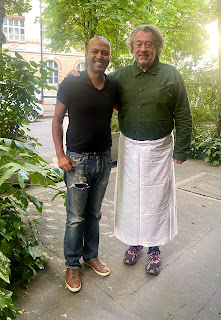#blahvsfood: Why Table by Bruno Verjus is the hottest restaurant in the world!
Table by Bruno Verjus is one of the hottest restaurants in the world. It was the highest new entry at last year’s list of the World’s 100 Best Restaurants debuting all the way at number 10. But its rise is as improbable as it is unparalleled. Because not only is Bruno Verjus not a trained chef, he wasn’t a chef at all till age 50. He was passionate about food and wrote about it but he lived most of his professional life pursuing completely unrelated careers. He studied medicine and has been a photographer, an entrepreneur in China, an author and even a radio host.
It was only at age 50 that he began his journey of actually cooking rather than consuming and commenting, and at this late stage has gone on to become one of the world’s most renowned chefs. His cooking is based on keeping things simple and letting ingredients shine, something that sounds easy but requires confidence and technical ability to pull off well.
 |
| Semi raw, semi cooked lobster |
The dish at Table that epitomises the skill and creativity needed to do this is the crab, a dish that is surprising and confusing because it has the rich buttery flavours of a classic French-style crab but with sweeter and firmer flesh than any cooked crab dish I’ve ever had. The secret lies in a novel approach. The shell of the crab is poached and slow cooked in butter to create a butter sauce with intense crab flavour but the meat of the crab isn’t. Instead, the is dipped into the sauce at 40 degrees for two minutes to absorb the flavours and create a buttery surface just before service. But the insides of the crab are almost raw, sashimi like, retaining its sweetness and freshness as well as firmness, creating a crab dish that is a new, fresh and reimagined version of the French classic.
 |
| Salmon cooked on one side |
The same approach is used to cook the salmon, where one side is cooked and the skin in grilled and charred while the other side is left almost raw with a light sear. This allows you to appreciate the different layers of the fish and takes what is often a boring fish, and elevates it to create a Multi-note sensory explosion in your mouth.
 |
| Chocolate, capers, hazelnut oil and caviar |
The focus is on heroing the ingredients, with subtle but innovative twists that allow you to look at the ingredient in a new light and also experience the flavours more deeply. He does a chocolate tart with dark Peruvian chocolate but infuses it with a caper cream to heighten the richness and add an acidic contrast. And to top it off, it’s not the usual sea salt but Ossetra caviar, creating not just a textural element but allowing the flavour of the caviar to really pop.
The best part of the restaurant in some ways is how humble and approachable Chef Bruno is. If you reach early, you’ll find him sitting outside and you can sit and chat with him over a glass of wine. And even if you don’t, chances are you will still meet him when he comes over to serve you a course and explain it during the course of the evening.
 |
| Bonbon, gratin and oysters |
I can see why this is the hottest restaurant in the world because it applies a cerebral approach to identify the essence of simplicity, and pushes the envelope in terms of capturing it on a plate. This is a must do for anyone who wants to understand modern French cuisine and its future.
I ate (with apologies for inaccuracies because I’m trying to do a translation from French):
Colours of the day: Seedlings, flowers, fruit and vegetables in a vegetable vinaigrette, fig leaf oil, Trikalinos bottarga- Bonbon: Raw cuttlefish, virgin cucumber broth
Stiffened natural oysters, mole in remoulade condiment, water spinach- Gratin. Saffron, yellow zucchini mousseline, streusel
Green washing: cucumber, blackcurrant and roses
Donburi: blonde lentils from Champeix cooked like a risotto, rice of white creamy lobster coral
Foaming turmeric carrots and pickled herbs- Semi raw, semi cooked: Lobster from the Yeu locker, tomatoes, nettle and caper remoulade, halophile garden
One sided cooked Adour salmon, grilled skin. Solta olive oil sabayon and oil of young Sichuan pepper buds, patissons, onions, butter beans
Veal chop roasted and suffused with lime blossom, full bodied veal and shrimp jus, fisherman’s potato- Cheeses from Bernard Antony
Apricot in sleet, iced almond milk, Umeshu- Peruvian chocolate tartlet: Infusion of Linosa capers and Ossetra caviar, hazelnut oil
Madeleine with olive, almond and citrus jam, Kardamili olive oil














Comments